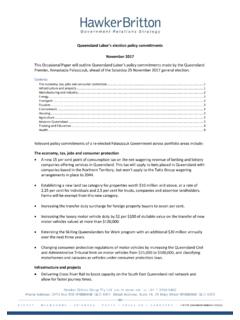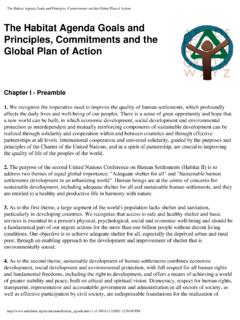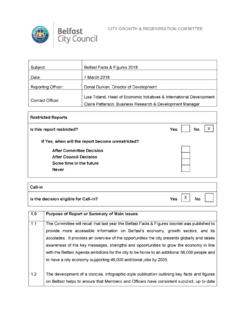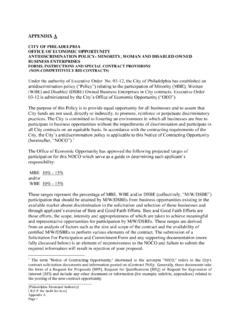Transcription of New York City Filtration Avoidance Determination
1 FINAL REVISED 2007 FAD New york city Filtration Avoidance Determination Prepared By NYSDOH in consultation with USEPA May 2014 Mid-Term Revisions to the 2007 Surface Water Treatment Rule Determination for New york city s Catskill/Delaware Water Supply System i Table of Contents Acronyms .. ii Executive Summary .. iv 1. Background and Basis for Determination and Revisions .. 1 2. SWTR Filtration Avoidance Criteria Requirements .. 18 3. Environmental Infrastructure Programs .. 22 Septic and Sewer Programs .. 22 New Sewage Treatment Infrastructure 25 Community Wastewater Management Program .. 26 Wastewater Treatment Plant Upgrade Program .. 28 Stormwater 29 4. Protection and Remediation Programs .. 31 Waterfowl Management Program .. 31 Land Acquisition Program .. 33 Land Management Program .. 40 Watershed Agricultural Program.
2 42 Watershed Forestry Program .. 45 Stream Management Program .. 47 Riparian Buffer Protection Program .. 53 Wetlands Protection Program .. 55 East-of-Hudson Nonpoint Source Pollution Control Program .. 56 Kensico Water Quality Control .. 59 Catskill Turbidity Control .. 61 Sand and Salt Storage .. 68 5. Watershed Monitoring, Modeling, and GIS Programs .. 69 Watershed Monitoring Program .. 69 Multi-Tiered Water Quality Modeling Program .. 71 Geographic Information System Program .. 73 6. Regulatory Programs .. 75 Watershed Rules and Regulations and Other Enforcement/Project Review .. 75 Wastewater Treatment Plant Compliance and Inspection Program .. 77 7. Catskill/Delaware Filtration and UV Disinfection Facilities .. 79 8. In- city Programs .. 81 Waterborne Disease Risk Assessment Program .. 81 Cross Connection Control Program .. 83 9. Administration.
3 85 10. Education and Outreach .. 86 11. 88 ii Acronyms AOC Administrative Order on Consent BMPs Best Management Practices CAP Cryptosporidium Action Plan CATUEC Catskill Aqueduct Upper Effluent Chamber CDUV Catskill/Delaware Ultraviolet Facility CCE Cornell Cooperative Extension CE Conservation Easement CFR Code of Federal Regulations CREP Conservation Reserve Enhancement Program CSBI Catskill Stream Buffer Initiative CT Concentration-Time (chlorine contact time) CWC Catskill Watershed Corporation DDBPR Disinfection and Disinfectant Byproducts Rule EOH East-of-Hudson EOHWC East-of-Hudson Watershed Corporation EPA United States Environmental Protection Agency EWP Emergency Watershed Protection FAD Filtration Avoidance Determination FBO Flood Buy-Out FEMA Federal Emergency Management Agency FIRMs Flood Insurance Rate Maps GIS Geographic Information System HAA5 Haloacetic Acids (sum of five)
4 IESWTR Interim Enhanced Surface Water Treatment Rule KAP Kensico Action Plan LAP Land Acquisition Program LFHMP Local Flood Hazard Management Program LT2 Long Term 2 Enhanced Surface Water Treatment Rule MAP Forestry Management Assistance Program MCL Maximum Contaminant Level MGD Million Gallons per Day MOA New york city Watershed Memorandum of Agreement MOU Memorandum of Understanding NIP New Sewage Treatment Infrastructure Program NPS Nonpoint Source NYC New york city NYCDEP New york city Department of Environmental Protection NYCRR New york [State] Codes, Rules, and Regulations NYS New york State NYSDEC New york State Department of Environmental Conservation NYSDOH New york State Department of Health O&M Operations and Maintenance OST Operations Support Tool PFM Precision Feed Management PHL New york State Public Health Law RWBT Rondout West Branch Tunnel SDWA Safe Drinking Water Act SEQRA State Environmental Quality Review Act SOEM New york State Office of Emergency Management SMP Stream Management Program iii SMIP Stream Management Implementation Grant Program SPDES State Pollutant Discharge Elimination System SWPPP Stormwater Pollution Prevention Plan SRP Septic Repair Program SWTR Surface Water Treatment Rule TAP Turbidity Action Plan TCR Total Coliform Rule TTHM Total Trihalomethanes USEPA United States Environmental Protection Agency USGS Unites States Geological Survey UV Ultraviolet WAC Watershed Agricultural
5 Council WAP Watershed Agricultural Program WDRAP Waterborne Disease Risk Assessment Program WECC Watershed Enforcement Coordination Committee WOH West-of-Hudson WPS Wetlands Protection Strategy WR&Rs Watershed Rules and Regulations WSP Water Supply Permit WWTP Wastewater Treatment Plant WQIP Water Quality Investment Program iv Mid-Term Revisions to the 2007 Filtration Avoidance Determination Executive Summary In July 2007, the United States Environmental Protection Agency (EPA), in consultation with the New york State Department of Health (NYSDOH), made a Determination that New york city ( the city ) has a long-term watershed protection program for its Catskill/Delaware water supply that adequately meets the requirements of the Surface Water Treatment Rule (SWTR) and the Interim Enhanced Surface Water Treatment Rule (IESWTR) for unfiltered water supply systems.
6 The resulting 2007 Filtration Avoidance Determination (FAD) covered a watershed protection program to be undertaken by the city over the next ten years, broken into two five year periods: (i) 2007-2012 ( First Five Year Period ), and (ii) 2012-2017 ( Second Five Year Period ). The 2007 FAD required the city to undertake a ten-year land acquisition program, which built upon and expanded the land acquisition provisions contained in the city 's 2006 Long-Term Watershed Protection Program ( 2006 Long-Term Plan ). In addition, during the First Five Year Period, the city committed to engaging in activities in a number of additional programs other than land acquisition ( Other Programs ). As described by the 2007 FAD, at the end of the First Five Year Period, with the primacy agency taking the lead, EPA and NYSDOH would conduct a review of the city s implementation of its 2006 Long-Term Plan and compliance with the requirements of the FAD.
7 In addition, the city was required to evaluate, in consultation with EPA and NYSDOH, which of the Other Programs should be continued into the Second Five Year Period, whether and how the Other Programs to be continued should be revised, and/or whether additional programs are necessary to ensure that the city continues to have an adequate long-term watershed protection program that meets the requirements of the SWTR and the IESWTR for unfiltered water supply systems. These evaluations, combined with input from watershed stakeholders, formed the basis for developing this mid-term revision to the 2007 FAD ( Revised 2007 FAD ). With the issuance of this Revised 2007 FAD, the city will be required to meet the commitments defined in this document for the Other Programs, as well as the Land Acquisition Program, for the remaining period of the 2007 FAD. The Revised 2007 FAD supersedes the 2007 FAD and will be applicable until a further Determination is made, currently scheduled for May 2017.
8 However, at any time, the primacy agency may make a Determination that the city s watershed program no longer provides adequate protection of the city s water supply, pursuant to the SWTR/IESWTR and/or other Avoidance criteria in the SWTR/IESWTR, and require the city to filter its Catskill/Delaware water supply. 1 1. Background and Basis for Determination and Revisions As required under the Safe Drinking Water Act (SDWA) Amendments of 1986, EPA promulgated the SWTR on June 29, 1989, specifying the criteria pursuant to which Filtration is required as a treatment technique for public water systems supplied by a surface water source. The SWTR is codified in Subpart H of 40 CFR, Part 141 - National Primary Drinking Water Regulations. The SWTR was promulgated to reduce the risk of waterborne disease occurrence from microbial contaminants at public water systems with surface water sources, either through Filtration or by meeting the stringent water quality, disinfection, and site-specific Avoidance criteria which make Filtration unnecessary.
9 In response to requirements set forth in the 1996 Amendments to the SDWA, EPA amended the SWTR on December 16, 1998, with the Interim Enhanced Surface Water Treatment Rule (IESWTR), which is codified in Subpart P of 40 CFR, Part 141, and again on January 5, 2006 with the Long Term 2 Enhanced Surface Water Treatment Rule (LT2), which is codified in Subpart W of 40 CFR, Part 141. The IESWTR requires unfiltered systems to meet additional provisions to remain unfiltered, including compliance with more stringent disinfection byproduct maximum contaminant levels and the requirement to address Cryptosporidium in their watershed control programs. The LT2 provisions for unfiltered systems are not specifically identified as requirements for Filtration Avoidance , but do require that unfiltered systems provide treatment for Cryptosporidium. The following criteria, which are established by the SWTR (40 CFR and ) and the IESWTR (40 CFR ), must be met in order to maintain Filtration Avoidance .
10 Applicable sections of Title 10 of the NYS Codes, Rules and Regulations (NYCRR), Subpart 5-1 are cited following the corresponding federal code citations. Source water quality conditions: (a)(1), (c)(1): Fecal or total coliform concentration requirements (a)(2), (c)(2): Turbidity level requirements Site-specific conditions: (b)(1)(i)/ (a)(1), (c)(3): Disinfection and CT requirements. (b)(1)(ii)/ (a)(2), (c)(4): Redundant disinfection components and auxiliary power supply requirements. (b)(1)(iii) (a)(3), (c)(5): Entry point residual disinfectant concentration requirements. (b)(1)(iv)/ (a)(4), (c)(6): Distribution system residual disinfectant concentration requirements. (b)(2), (c)(7)(i)-(vii): Maintain a watershed control program which minimizes contamination by Giardia lamblia cysts and viruses, and through which the public water system operator demonstrates adequate control over activities that may have an adverse impact on the microbiological quality of the source water.
















